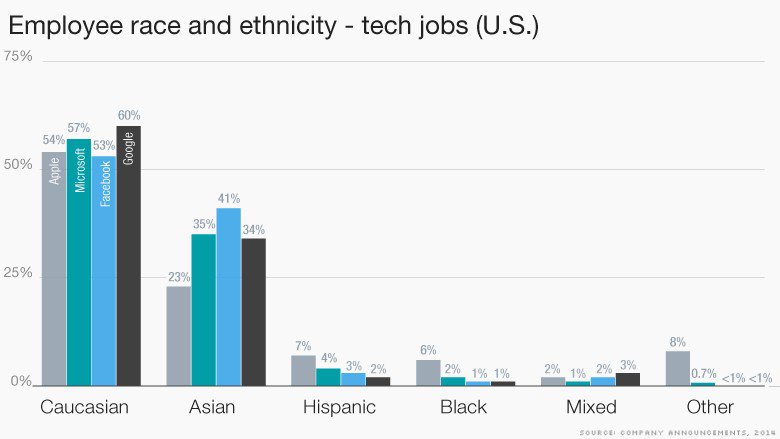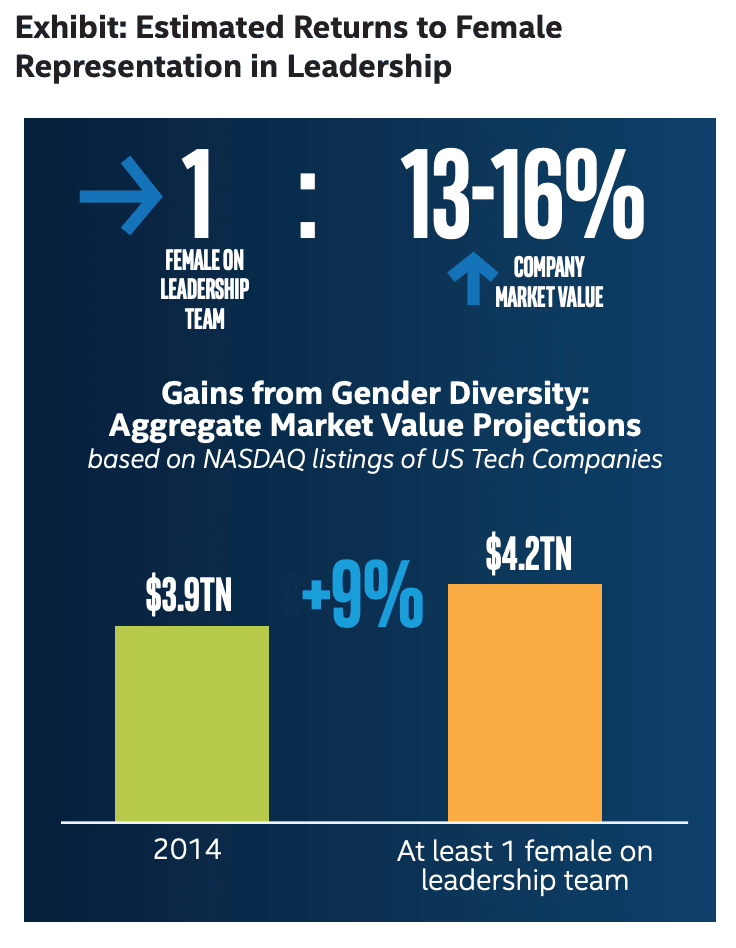Por qué la diversidad y la representación son importantes en la industria tecnológica
La diversidad es algo de lo que el mundo de la tecnología lleva décadas hablando. Hay paneles en conferencias, libros, podcasts y mucho más dedicado al tema.
Y, sin embargo, las cifras siguen siendo bastante desalentadoras.

Marginalized groups – namely women and minorities – are still severely underrepresented in tech.
¿A qué se debe? ¿Y cómo podemos solucionarlo?
Let’s explore. 👇
El dilema de la diversidad
Si nos fijamos en algunas de las empresas más importantes de Silicon Valley, son abrumadoramente masculinas y abrumadoramente blancas (con una gran mayoría de empresas con una plantilla inferior a 10% negra y/o latina).
Of the $85 billion invested by venture capitalists in 2017, only $1.9 billion went to women-led teams – that’s 2.2% in total. 👎
E incluso los equipos mixtos (o de género no confirmado) sólo recaudaron 19% de esa cifra de $85 mil millones.
When it comes to the racial disparities in funding, there’s a wide gap in the number of black and Latinx investment professionals who work at VC funds – the number was as low as 3% in 2016.
And we haven’t even mentioned the pay gap yet. 💸
Las mujeres en profesiones STEM ganan, de media, $16.000 menos al año que sus homólogos masculinos.

O, si eres negro o latino y trabajas en una profesión STEM, puede que ganes $14.000 menos que tu compañero blanco.
Noticing a pattern? 🤔
¿Cómo hemos llegado hasta aquí?
If we look at Emily Chang’s Brotopia, an insightful and well-researched book that chronicles the major gender disparities in Silicon Valley, it wasn’t always this way.
By the time the Macintosh was introduced in the 1980s, women were earning 40% of computer science degrees. 👩💻
Hubo varias mujeres pioneras en tecnología en este punto. Al fin y al cabo, la primera línea de código informático la escribió Ada Lovelace en la década de 1840.
Pero entonces se produjo un cambio.

“Just as computers began to head into the mainstream, women’s participation in the field started to plummet,” Chang writes.
En la última década aproximadamente, el porcentaje de mujeres que obtienen títulos de informática se ha mantenido estable en torno al 22%.
Por supuesto, hay muchos factores en juego.
It goes beyond sexism or racism. There are microaggressions happening all the time in tech company offices – what’s frustrating about this is that it can sometimes be hard to pinpoint or call out.
Por ejemplo, las ingenieras se enfrentan a 35% más rechazos de su código.
And from an anecdotal standpoint, another example would be infamous VCs holding parties that would make women uncomfortable, though of course, to men, it’s just a way for them to see if entrepreneurs can “hang.”
La falta de modelos a seguir puede ser otro factor. Hay muy, muy pocas mujeres y minorías en los puestos más altos de las empresas tecnológicas.

It can also be chalked up internalized doubt. Many marginalized people, if not all in some way or another, are socialized and educated in subtle ways throughout their lives to doubt themselves (thankfully, this is being tackled by organizations such as Endeavor – check it out!).
This can often come in the form of “Impostor Syndrome,” a phenomenon that describes the feeling of being undeserving of your success, an “impostor.”
El fenómeno afecta desproporcionadamente a mujeres y minorías, pero en una cultura empresarial que anima a vender ideas e inflar su valía, esto es problemático.

There are, of course, many other tangible and intangible factors as well. A person’s upbringing can greatly impact the way they perceive their career path.
For example, something seemingly harmless such as giving dolls to young girls and Legos to young boys can further exacerbate outdated gender roles. 🙅♀️
Pero, dicho todo esto, ¿cómo sería el mundo de la tecnología si fuera más diverso?
There’s truth in the numbers
Beyond the obvious “it’s the right thing to do” mindset of having more diversity and representation in the tech world, it also just makes good business sense.
A study from McKinsey & Company found that companies in the top quartile for gender or racial and ethnic diversity are “more likely to have financial returns above their national industry medians.”
¿Y el cuartil inferior de estas dimensiones? Estadísticamente tienen menos probabilidades de lograr estos rendimientos.

As mentioned in their findings, “diversity is probably a competitive differentiator that shifts market share toward more diverse companies over time.”
From a financial standpoint, according to Forbes, female tech entrepreneurs are able to generate 20% more revenue than their male counterparts – despite starting their companies with 50% less capital. 💪
On top of that, the European Commission calculates that through the further inclusion of women working in tech, the EU’s GDP could see an annual boost of €16 billion.
The numbers are even more incredible in the US. In Intel’s Decoding Diversity report, they concluded, as we’ve already seen, that diversity leads to higher revenues, profits and market value.

Pero va más allá: mejorando la diversidad e inclusión étnicas y de género en la mano de obra tecnológica estadounidense, podría crear entre $470.000 millones y $570.000 millones en nuevo valor para la industria.
That’s a lot of zeros. 😲
Más allá de las cifras
Entonces, ¿por qué exactamente la diversidad da mejores resultados?
Porque la similitud mata la innovación.
La diversidad en la forma de pensar y resolver los problemas de los equipos contribuye al éxito.
Una mejor representación de los grupos marginados es crucial para encontrar las soluciones adecuadas a los retos, el pensamiento creativo y el éxito general de los clientes.
Cuando los miembros del equipo son demasiado parecidos, las cosas pueden pasar desapercibidas o pasarse por alto.
Let’s put it this way: diverse teams win more often and more consistently.
Además, contar con equipos más diversos significa que su empresa está al servicio de todos los clientes, no sólo de sí misma.
El mundo está lleno de personas de orígenes y perspectivas muy diversos. Para crear y construir una empresa que sirva a todos, los equipos necesitan escuchar a quienes tienen experiencias diversas.
¿Adónde vamos ahora?
There are already some companies and government organizations that are pushing for more representation in the tech industry – but it needs to go further (and not just result in simple quotas).
Going back to Cheng’s Brotopia, she suggests:
- nombramiento de mujeres en los consejos de administración,
- contratar a más mujeres socias
- y la contratación de más mujeres capitalistas de riesgo.
- Lo mismo debería hacerse con todos los grupos marginados, por supuesto.
But most importantly: the tech industry needs to stop blaming everyone else for the problem. 😕
En Silicon Valley, el fracaso es algo que se celebra, ya que puede ayudar a aprender (y finalmente a triunfar). Sin embargo, la industria tecnológica lleva demasiado tiempo fallando a los grupos marginados.

As Cheng explains, “it’s time for the industry to own it.”
Los datos han demostrado una y otra vez que una plantilla más diversa no sólo es más eficiente y rentable, sino que también ofrece a las empresas la oportunidad de escuchar perspectivas que antes no estaban presentes.
It’s crucial for companies to have more intersectional voices heard across the tech industry, especially in leadership functions, and to encourage more diversity to ensure that they are creating solutions and technology for the modern world: one that is filled with people from different walks of life.
¿Vamos a resolver el problema con esta única entrada del blog? Por supuesto que no.
But we need to be having these conversations. And more importantly, we need to be doing something about it. 🗣

We can speak at diversity panels until our faces turn blue, but until those in the higher echelons of the tech world encourage and drive the conversation – and take meaningful actions for change – things are going to remain the status quo.
And, well, that’s just bad business. 🤷♀️
Esperamos que te haya gustado este post. Si es así, ¡difúndelo!
Para más información sobre startups, marketing de crecimiento y ventas:
👉 follow @salesflare on Twitter o Facebook
- 22+ Los mejores podcasts de ventas que deberías ver en 2024 - 21 de diciembre de 2023
- Guiones de llamada en frío para seres humanos reales - 21 de septiembre de 2023
- Las más de 25 mejores herramientas de ventas para ayudar a tu equipo a tener éxito - agosto 10, 2023
